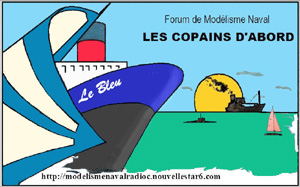Du bon usage du mot "Compound"
FORUM MODELISME NAVAL RADIOCOMMANDE :: MODELISME NAVAL :: MODELISME BATEAUX A VAPEUR :: VU SUR LE NET & BONNES AFFAIRES
Page 1 sur 1
 Du bon usage du mot "Compound"
Du bon usage du mot "Compound"
Bonjour,
Je me trompais depuis longtemps sur la caractéristique des moteurs "compound".
Je réservais ce mot aux moteurs composés uniquement de 2 cylindres, un Haute Pression (HP) alimentant un Basse Pression (BP).
En fait, tout moteur composé de cylindres montés en cascade, optimisant ainsi le travail de la vapeur est un moteur "compound".
Ce que je croyais être une définition est seulement un usage.
Je suis heureux d'avoir encore appris maintenant, et je souhaite en profiter pour remercier kbio qui m'a trouvé l'information précise.
C'est un texte dans sa langue originale que je partage avec vous, les traducteurs de la Toile sauronty vous aider si besoin.
As steam expands in a high pressure engine its temperature drops; because no heat is released from the system, this is known as adiabatic expansion and results in steam entering the cylinder at high temperature and leaving at low temperature. This causes a cycle of heating and cooling of the cylinder with every stroke which is a source of inefficiency.
A method to lessen the magnitude of this heating and cooling was invented in 1804 by British engineer Arthur Woolf, who patented his Woolf high pressure compound engine in 1805. In the compound engine, high pressure steam from the boiler expands in a high pressure (HP) cylinder and then enters one or more subsequent lower pressure (LP) cylinders. The complete expansion of the steam now occurs across multiple cylinders and as less expansion now occurs in each cylinder so less heat is lost by the steam in each. This reduces the magnitude of cylinder heating and cooling, increasing the efficiency of the engine. To derive equal work from lower pressure steam requires a larger cylinder volume as this steam occupies a greater volume. Therefore the bore, and often the stroke, are increased in low pressure cylinders resulting in larger cylinders.
Double expansion (usually known as compound) engines expanded the steam in two stages. The pairs may be duplicated or the work of the large LP cylinder can be split with one HP cylinder exhausting into one or the other, giving a 3-cylinder layout where cylinder and piston diameter are about the same making the reciprocating masses easier to balance.
Je me trompais depuis longtemps sur la caractéristique des moteurs "compound".
Je réservais ce mot aux moteurs composés uniquement de 2 cylindres, un Haute Pression (HP) alimentant un Basse Pression (BP).
En fait, tout moteur composé de cylindres montés en cascade, optimisant ainsi le travail de la vapeur est un moteur "compound".
Ce que je croyais être une définition est seulement un usage.
Je suis heureux d'avoir encore appris maintenant, et je souhaite en profiter pour remercier kbio qui m'a trouvé l'information précise.
C'est un texte dans sa langue originale que je partage avec vous, les traducteurs de la Toile sauronty vous aider si besoin.
As steam expands in a high pressure engine its temperature drops; because no heat is released from the system, this is known as adiabatic expansion and results in steam entering the cylinder at high temperature and leaving at low temperature. This causes a cycle of heating and cooling of the cylinder with every stroke which is a source of inefficiency.
A method to lessen the magnitude of this heating and cooling was invented in 1804 by British engineer Arthur Woolf, who patented his Woolf high pressure compound engine in 1805. In the compound engine, high pressure steam from the boiler expands in a high pressure (HP) cylinder and then enters one or more subsequent lower pressure (LP) cylinders. The complete expansion of the steam now occurs across multiple cylinders and as less expansion now occurs in each cylinder so less heat is lost by the steam in each. This reduces the magnitude of cylinder heating and cooling, increasing the efficiency of the engine. To derive equal work from lower pressure steam requires a larger cylinder volume as this steam occupies a greater volume. Therefore the bore, and often the stroke, are increased in low pressure cylinders resulting in larger cylinders.
Double expansion (usually known as compound) engines expanded the steam in two stages. The pairs may be duplicated or the work of the large LP cylinder can be split with one HP cylinder exhausting into one or the other, giving a 3-cylinder layout where cylinder and piston diameter are about the same making the reciprocating masses easier to balance.
Invité- Invité
 Sujets similaires
Sujets similaires» Petit lexique à l'usage de la vapeur du forum!
» Compound BR 20/34
» Le Compound de Papymouzot
» Machines "Compound " en modélisme
» moteur compound de GRAINE AU VENT
» Compound BR 20/34
» Le Compound de Papymouzot
» Machines "Compound " en modélisme
» moteur compound de GRAINE AU VENT
FORUM MODELISME NAVAL RADIOCOMMANDE :: MODELISME NAVAL :: MODELISME BATEAUX A VAPEUR :: VU SUR LE NET & BONNES AFFAIRES
Page 1 sur 1
Permission de ce forum:
Vous ne pouvez pas répondre aux sujets dans ce forum